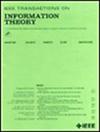模拟纠错码:设计与分析
IF 2.2
3区 计算机科学
Q3 COMPUTER SCIENCE, INFORMATION SYSTEMS
引用次数: 0
摘要
罗思最近提出了一种新型模拟纠错码(Analog ECCs)。这种纠错码可以纠正无限大小的错误,即使码字不仅会受到这些错误的影响,还会受到无处不在的有限大小的噪声的影响。通过在纳米级模拟电路中的实施,这些编码有可能加速机器学习中广泛使用的向量矩阵乘法。目前已提出了几种模拟 ECC,主要侧重于纠正或检测单个无限幅度的错误。本文从多个方面探讨了模拟 ECC 的分析和构造。它提出了一种基于线性编程的算法,该算法能高效计算模拟 ECC 的 m 高,可用于确定编码的纠错/检测能力。然后,它提出了基于排列的模拟 ECC 系列,并证明确定此类编码 m 高的时间复杂度可进一步大幅降低。该分析为编码搜索和性能验证之间的时间复杂度权衡奠定了基础。论文随后介绍了一些基于这种搜索和验证过程的新发现的代码,它们达到了最先进的性能。本文章由计算机程序翻译,如有差异,请以英文原文为准。
Analog Error-Correcting Codes: Designs and Analysis
A new type of analog error-correcting codes (Analog ECCs) has been proposed by Roth recently. The codes can correct errors of unlimited magnitudes even though the codeword is affected not only by such errors, but also by ubiquitous noise of limited magnitudes. The codes have the potential to accelerate the widely used vector-matrix multiplication in machine learning via their implementation in nanoscale analog circuits. Several Analog ECCs, which mainly focus on correcting or detecting a single unlimited-magnitude error, have been proposed. This paper explores the analysis and constructions of Analog ECCs in multiple ways. It presents a linear-programming based algorithm that computes the m-heights of Analog ECCs efficiently, which can be used to determine the error correction/detection capabilities of the codes. It then presents a family of Analog ECCs based on permutations, and proves that the time complexity for determining the m-heights of such codes can be further reduced substantially. The analysis forms a basis for the time-complexity tradeoff between the searching of codes and the verification of their performance. The paper then presents a number of newly discovered codes based on such a search and verification process, which achieve state-of-the-art performance.
求助全文
通过发布文献求助,成功后即可免费获取论文全文。
去求助
来源期刊

IEEE Transactions on Information Theory
工程技术-工程:电子与电气
CiteScore
5.70
自引率
20.00%
发文量
514
审稿时长
12 months
期刊介绍:
The IEEE Transactions on Information Theory is a journal that publishes theoretical and experimental papers concerned with the transmission, processing, and utilization of information. The boundaries of acceptable subject matter are intentionally not sharply delimited. Rather, it is hoped that as the focus of research activity changes, a flexible policy will permit this Transactions to follow suit. Current appropriate topics are best reflected by recent Tables of Contents; they are summarized in the titles of editorial areas that appear on the inside front cover.
 求助内容:
求助内容: 应助结果提醒方式:
应助结果提醒方式:


